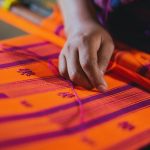To keep the nap of your corduroy consistent, first identify its direction by feeling and visually checking the fabric’s texture and sheen. Lay all pattern pieces with the nap running the same way, and mark each piece clearly on the wrong side with an arrow labeled “Nap.” Cut from a single fabric fold to avoid flipping pieces upside down. Before sewing, double-check that all cut pieces have matching nap direction for a polished look. Follow these steps carefully, and you’ll achieve flawless results with your project.
Table of Contents
Key Takeaways
- Identify the nap direction by touch and visual inspection before laying out pattern pieces.
- Align all pattern pieces so their grainlines run parallel to the fabric’s nap direction.
- Mark the nap direction clearly on the wrong side of each pattern piece before cutting.
- Avoid flipping pattern pieces upside down to prevent uneven color and texture.
- Double-check all cut pieces for consistent nap alignment before sewing.
Understanding the Nap Direction in Corduroy Fabric
Nap direction in corduroy refers to the way the fabric’s raised ridges, or wales, lie. When you run your hand along the fabric, you’ll notice the wales feel smooth in one direction and rougher in the other.
This texture difference is what defines the nap. Understanding this is essential because the nap affects how the fabric reflects light, which can change the appearance of your finished garment.
The nap’s texture influences light reflection, altering your garment’s final look significantly.
If you don’t align all pattern pieces with the nap going the same way, your project may look uneven or patchy. So, always be aware of the nap’s direction before you start cutting.
Consistency in nap direction guarantees a polished, professional look in your corduroy creations.
Identifying the Nap Before Cutting
Before you start cutting, make sure you can clearly identify the fabric’s nap direction. Corduroy’s nap affects how light reflects off the ridges, so spotting it’s key.
Here’s how you can do it:
- Touch Test: Run your fingers across the fabric. The nap feels smooth one way and rougher the opposite.
- Visual Check: Tilt the fabric under light; the pile looks darker when viewed against the nap and lighter with it.
- Brush Lightly: Use a soft brush or your hand to gently sweep the fabric. The pile shifts direction, revealing the nap’s flow.
Laying Out Pattern Pieces With Nap Alignment
When you lay out your pattern pieces, always align them with the fabric’s nap to secure uniform texture and color across your project.
Start by placing all pieces so their grainlines run parallel to the nap direction identified earlier. This guarantees the pile faces the same way on every piece.
Align pattern pieces with the nap so grainlines run parallel, ensuring consistent pile direction throughout.
Avoid flipping pieces upside down or against the nap, as this creates visible color shifts when sewn together. Use pattern weights or pins to keep pieces flat and steady without distorting the fabric.
If your pattern has symmetrical pieces, lay them out consistently on the same nap side to maintain uniformity.
Taking these steps during layout prevents mismatched texture, helping your finished garment look professional and cohesive.
Marking the Nap Direction on Your Pattern Pieces
Although aligning your pattern pieces with the fabric’s pile is essential, you also need to clearly mark the nap direction on each piece before cutting. This prevents confusion during assembly and guarantees all pieces face the same way.
Here’s how to mark the nap effectively:
- Use a fabric-safe marking tool, like tailor’s chalk or a washable fabric pen, to draw an arrow indicating the nap direction on the wrong side of each pattern piece.
- Write “Nap” or “Pile” next to the arrow to reinforce the direction visually.
- Double-check each piece against your fabric’s nap before cutting to confirm consistency.
Using a Single Fabric Fold to Maintain Nap Consistency
Choosing a single fabric fold for cutting all your pattern pieces guarantees the nap runs uniformly across your project. When you fold the corduroy fabric so both layers have the nap running in the same direction, you prevent any mismatch in texture or color shading.
This way, every piece you cut aligns perfectly with the nap’s flow, simplifying assembly and enhancing the finished look. You’ll avoid surprises like one sleeve appearing darker or lighter than the other because the nap lies differently.
Make sure to double-check the nap direction before folding, then place your pattern pieces accordingly. By sticking to one consistent fold, you maintain control over the fabric’s unique characteristics, ensuring your project looks professional and cohesive throughout.
Tips for Cutting Corduroy With a Consistent Nap
To cut corduroy with a consistent nap, you’ll need to pay close attention to the fabric’s direction and use sharp tools to achieve clean edges.
First, always lay out your fabric so the nap runs in the same direction for all pattern pieces.
Second, pin your pattern pieces carefully, ensuring they don’t shift and disrupt the nap alignment while cutting.
Third, use a sharp rotary cutter or scissors to slice through the fabric cleanly, preventing frayed edges that can obscure the nap’s direction.
By following these steps, you’ll keep your corduroy pieces uniform, which is essential for a professional-looking finished garment.
Handling Pattern Pieces That Need to Be Cut on the Fold
When you work with pattern pieces that need to be cut on the fold, you must align the fabric carefully to maintain the nap’s direction.
Lay your corduroy flat with the nap running in the desired direction, then fold it so the edges meet precisely. Place the pattern piece on the fold line, ensuring the nap runs the same way on both layers.
Pin the pattern securely to prevent shifting, especially since corduroy’s texture can cause fabric to move. Avoid flipping the fabric or pattern piece, as that will reverse the nap and create visible inconsistencies in your final garment.
Checking Nap Consistency Before Sewing
After cutting your pattern pieces with careful attention to the nap, you’ll want to double-check that the nap direction matches across all parts before sewing. This step prevents mismatched shading and texture that can ruin your finished garment’s look.
Here’s how to check nap consistency effectively:
- Lay all pieces flat, aligning edges to visually confirm the nap flows the same way.
- Run your hand gently over each piece’s surface; the pile should feel uniform in direction.
- Hold pieces up to light or tilt them slightly—consistent sheen and shadow indicate matching nap.
If any piece feels or looks off, reorient it before stitching. Taking this extra moment guarantees your corduroy project appears polished and professional.
Frequently Asked Questions
Can Washing Corduroy Affect Its Nap Direction?
Yes, washing corduroy can affect its nap direction by softening fibers and causing slight shifts. You’ll want to wash it before cutting to guarantee the nap stays consistent and your finished garment looks smooth and uniform.
What Tools Are Best for Cutting Corduroy Fabric?
When it comes to cutting corduroy, you’ll want sharp fabric scissors or a rotary cutter to get clean edges without fraying. Don’t forget a cutting mat if you use a rotary cutter—it’s the icing on the cake!
How Does Nap Consistency Impact Garment Durability?
You’ll find that nap consistency impacts garment durability by preventing uneven wear and fabric distortion. When all pieces align with the nap, your corduroy maintains strength and appearance longer, ensuring your garment lasts through regular use.
Are There Specific Thread Types Recommended for Sewing Corduroy?
You should use strong, polyester thread when sewing corduroy because it offers durability and flexibility. Cotton-wrapped polyester thread also works well, ensuring your seams stay secure without damaging the fabric’s texture or appearance.
Can Nap Direction Influence Fabric Color Appearance?
You know how the proof is in the pudding—nap direction does influence fabric color appearance. When light hits corduroy’s raised fibers differently, it creates shading variations, so always align pieces to keep the look consistent.
- Does Chiffon Fabric Stink - July 15, 2025
- Does Chiffon Fabric Affect the Economy - July 15, 2025
- Does Cotton Fabric Have a Nap - July 15, 2025







